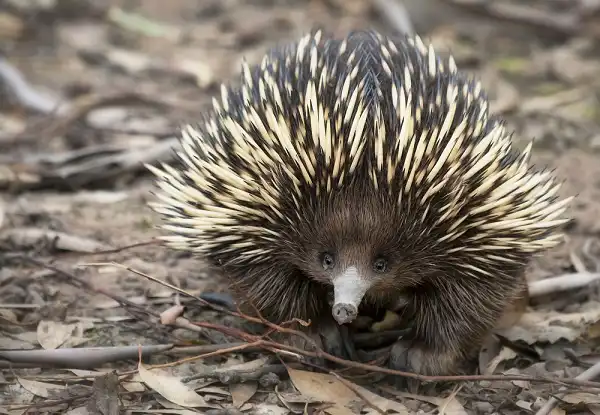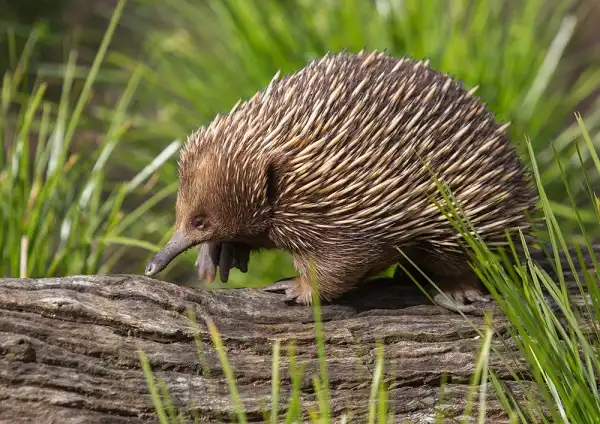Are you curious about the fascinating and intriguing creature of the animal kingdom known as an echidna? This primitive mammal has intrigued people for centuries with its striking physical features, including a long tubular snout, spiny fur, and long hind feet. Here we’ll delve deeper into this mysterious mammal to learn more about its behaviors, diet, natural habitat range, and more. Whether you’re a committed biologist or just casually interested in learning some interesting facts about mother nature’s creatures – this is sure to be an enlightening exploration!

Echidna Description
Join us as we explore the fascinating world of echidnas, one of the most unique creatures of the animal kingdom. These intriguing mammals boast a striking physical appearance, with their elongated snouts, spiny fur, and long hind feet. But there’s so much more to echidnas than just their looks. Echidnas also have a unique way of feeding. Their long snouts are perfectly adapted for probing the ground and finding insects to eat. They lack teeth, instead using their strong, muscular tongues to grind their food against their hard palates. In addition to their spiny coat, echidnas have powerful legs and sharp claws that allow them to dig for food and burrow into the ground for shelter. They also have a long, pointed snout that they use to detect prey, which is covered in sensitive electroreceptors similar to those found in sharks.
Echidna Habitat
Echidnas are widely distributed across Australia and New Guinea, inhabiting a range of diverse environments, from arid deserts to tropical rainforests. These fascinating mammals can be found throughout much of Australia, with the exception of Tasmania, and the island of New Guinea. Echidnas are solitary creatures that prefer to live in areas with plenty of covers, such as logs, rocks, and vegetation. They are particularly fond of areas with loose soil or sand, which allows them to easily dig for insects and other small prey. In the wild, echidnas are known to shelter in hollow logs or abandoned animal burrows during the day, emerging at night to forage for food. While they are generally found at elevations below 2000 meters, echidnas have been known to inhabit alpine and sub-alpine areas in certain parts of Australia. However, they are most commonly found in lowland habitats, such as woodlands, heathland, and grasslands. Despite their wide distribution, echidnas are vulnerable to habitat loss due to human activities such as grazing, land clearing for agriculture, and urban development.
Echidna Diet
The diet of echidnas is primarily made up of insects and other small invertebrates, which they locate by using their highly sensitive snouts to detect the electrical signals produced by their prey. They are known to consume vast amounts of ants and termites, which they lap up with their long, sticky tongues. In addition to insects, echidnas will also feed on small reptiles, amphibians, and mammals, as well as eggs and carrion. They have even been observed eating the grubs of the Christmas beetle, which are considered a delicacy in certain parts of Australia. Despite their relatively small size, echidnas have a surprisingly slow metabolism, which allows them to survive on a lower intake of food than other mammals of their size. Studies have shown that echidnas can survive for up to three months without food, and can reduce their metabolic rate by up to 25 percent during periods of food scarcity. Overall, the diet of echidnas is highly specialized and adapted to their unique physical characteristics. Their love of ants and termites in particular has made them an important part of many ecosystems, as they play a vital role in regulating the populations of these small invertebrates.

Echidna Size
Echidnas are relatively small animals, with an average length of 30-45 centimeters and a weight of 2-5 kilograms. However, they are known to vary in size based on their geographic location and the type of habitat they inhabit. In general, echidnas found in arid regions tend to be smaller than those found in more lush environments. One of the most distinctive features of echidnas is their spiny coat, which is composed of thousands of sharp, keratinous spines. These spines can range in length from 2.5 to 5 centimeters and provide excellent protection against predators. While echidnas cannot shoot their spines like porcupines, they are able to curl into a ball, exposing only their sharp spines, to deter would-be attackers.
Echidna Lifespan
When it comes to the lifespan of echidnas, much is still unknown. However, studies have shown that in the wild, these animals can live up to 50 years, with the average lifespan being around 15-20 years. One factor that may contribute to their long lifespans is their slow metabolism. As mentioned earlier, echidnas have a surprisingly slow metabolic rate, which allows them to survive on less food than other mammals of similar size. This slower rate of metabolism may also contribute to their longevity by reducing the buildup of free radicals in their bodies, which can damage cells and contribute to aging. In addition to their slow metabolism, echidnas have a number of other adaptations that may contribute to their long lifespans. For example, they have highly efficient immune systems that are able to fight off a wide range of pathogens and infections, which can be a major contributor to mortality in many animals. Another important factor that may contribute to the longevity of echidnas is their low reproductive rate.
Echidna Behavior
Echidnas are fascinating creatures that exhibit a wide range of behaviors that have evolved over millions of years to help them survive in challenging environments. Despite their small size, echidnas are highly adaptable and can thrive in a variety of habitats, from dry deserts to lush forests. One of the most interesting aspects of echidna behavior is their social structure. Unlike many other mammals, echidnas are typically solitary creatures, only coming together to breed. However, they have been known to share burrows and forage together in some situations, suggesting that they may have more complex social interactions than previously thought. Echidnas are also highly attuned to their surroundings and use a range of sensory cues to navigate and survive. Overall, echidnas are remarkable creatures with a complex set of behaviors and adaptations that make them highly effective survivors. As we continue to study and learn about these fascinating animals, we can gain a deeper appreciation for the incredible diversity of life on our planet, and work to protect these unique and important creatures for future generations.

Echidna Speed
Echidnas are known for being slow-moving mammals, taking their time to navigate their environment and forage for food. This is due to their surprisingly slow metabolic rate, which allows them to survive on less food than other mammals of similar size. However, don’t be fooled by their slow demeanor. Echidnas have been known to run at surprisingly fast speeds when threatened or chased by predators. In fact, they can run up to 25 miles per hour, making them one of the fastest monotremes (egg-laying mammals) in the world. Their ability to reach such high speeds is due to their powerful legs, which are specially adapted for digging and running. Echidnas also have sharp claws that help them gain traction and maneuver quickly, allowing them to escape danger and defend themselves if necessary. Despite their speed, echidnas are not built for sustained long-distance running. They are more suited to short bursts of speed, which they can use to evade predators or catch prey. Their primary mode of transportation is actually walking, and they can cover long distances by ambling along at a steady pace.
Echidna Hunting
Echidna hunting is a fascinating aspect of these unique animals’ behavior. While they are primarily insectivores, they have also been known to eat small vertebrates such as lizards, snakes, and rodents. Echidnas are adept hunters, using a combination of their sharp claws, powerful legs, sensitive electroreceptors, and keen sense of smell to locate and capture their prey. When hunting, echidnas will use their claws to dig into soil or leaf litter to uncover insects or other small prey. Their long, sticky tongues are then deployed to capture their target, which can be detected using their electroreceptors. Echidnas are also able to use their sense of smell to track prey, which can be especially helpful in partially hidden or underground environments. Despite their relatively slow movement, echidnas are highly effective hunters due to their unique adaptations. They can quickly dig into soil or vegetation to uncover prey, even in tough soil conditions. Their sharp claws and powerful legs also allow them to swiftly capture or defend themselves against both predators and prey.
Echidna Reproduction
One final interesting aspect of echidnas is their reproductive behavior. Unlike most mammals, these animals do not give birth to live young. Instead, they lay eggs and incubate them outside the body in a specialized pouch called a “brood patch” located on the mother’s belly. The gestation period for an echidna egg is about 10 days, after which time the mother will carefully move it into her brood patch where it will remain until she finds a safe place to bury it. The egg then hatches after another 10 days or so, at which point the tiny offspring (called a “puggle”) will emerge from its protective shell and begin its life in the wild.

Conclusion
Echidnas are remarkable and unique animals that have evolved a range of adaptations and behaviors that make them highly successful survivors. Their ability to run quickly when threatened, their skillful hunting techniques, and their slow metabolic rate, among other traits, all contribute to their success in the wild. By protecting echidnas and their habitats, we can ensure that future generations can marvel at these impressive creatures for years to come.
Frequently Asked Question


